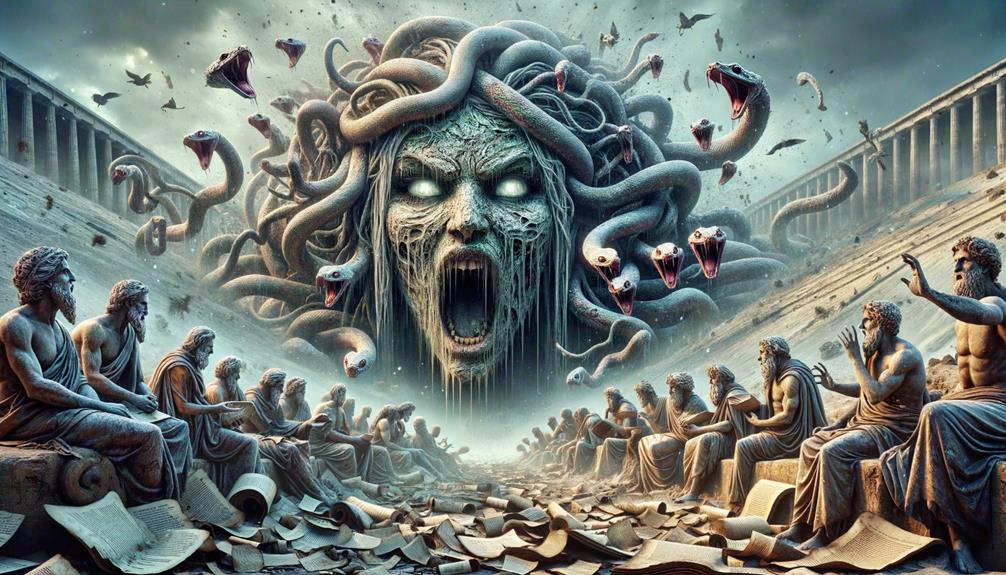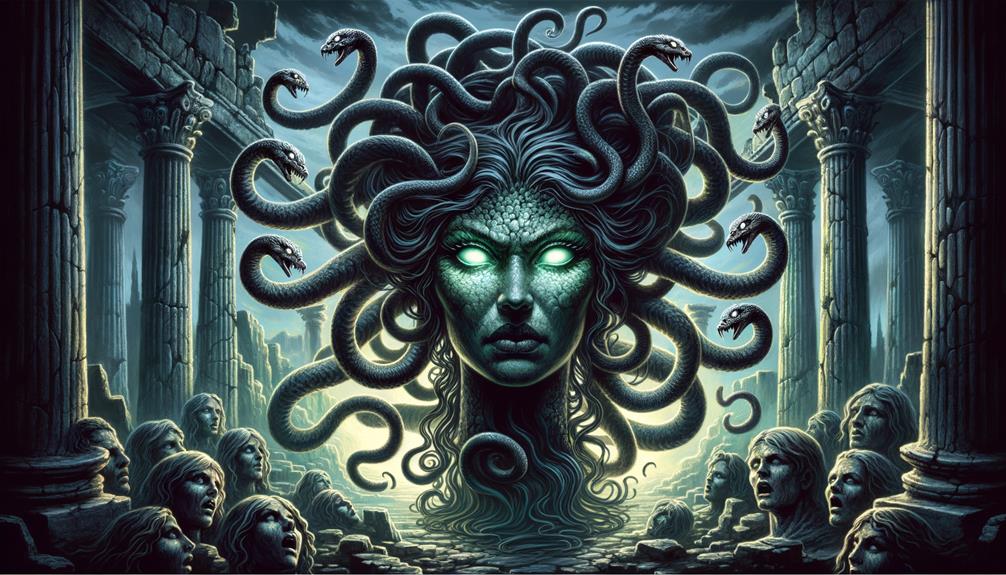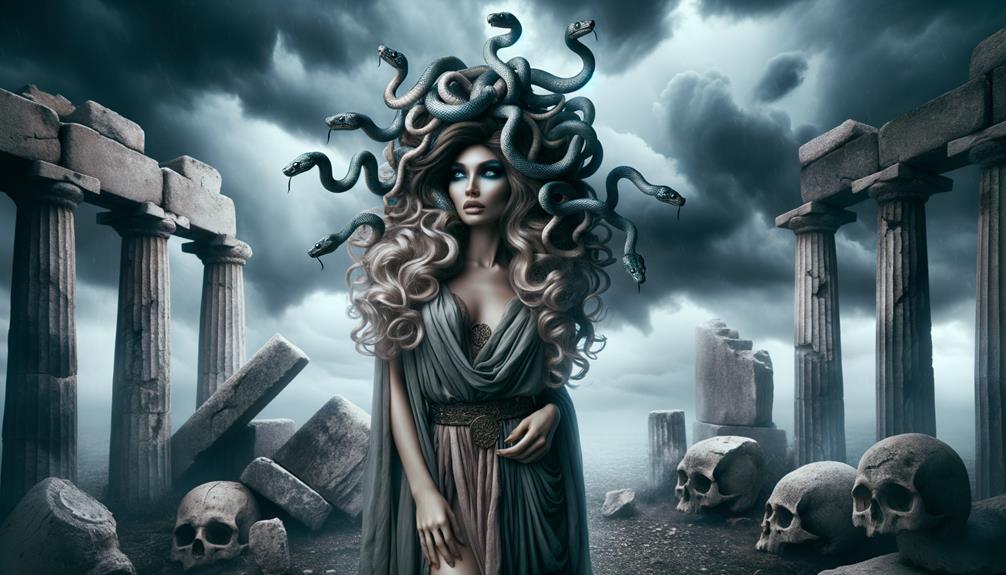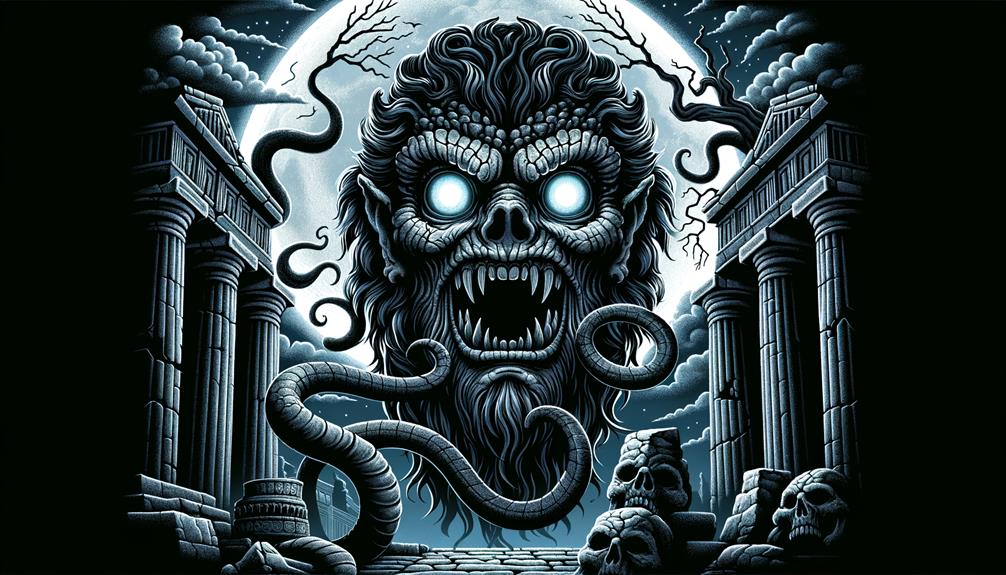Unraveling the Enigma of the Gorgon Greek Petrifying Demon
Isn't it intriguing to ponder the potential that the Gorgon Greek petrifying demon, particularly Medusa, might have connections to real events or, at the very least, the ancient people's fears and anxieties? I find myself delving into this hypothesis, sifting through layers of fact and fiction, striving to comprehend the symbolic implications of these terrifying entities.
In the realm of Greek mythology, the Gorgons are portrayed as horrifying creatures, their hair composed of living, venomous snakes, their gaze possessing the power to transform anyone into stone. But could this just be an intricate myth, or is there more to these creatures than initially apparent?
Let's embark on an exploration into the depths of the myth, the legend, and the persisting fascination with the Gorgon Greek petrifying demon. Along the way, we might just stumble upon some surprising revelations.
Gorgons in Greek Mythology: More than Just Monsters
The Gorgons, in Greek mythology, are often described as monstrous beings. However, could they symbolize more than just terror and dread? This question is worth investigating, as it might lead us to a deeper understanding of ancient Greek culture and belief systems.
For instance, Medusa, the most famous Gorgon, is known for her hair of living, venomous snakes. This could be a metaphor for the dangers that were present in the ancient world – from deadly creatures to the threats posed by other tribes or nations. Moreover, her ability to turn anyone into stone with her gaze might symbolize the power of fear, which can paralyze and immobilize us, turning us into 'stone'.
Diving Deeper into the Gorgon Greek Petrifying Demon
Let's continue our journey, delving deeper into the enigmatic allure of the Gorgon Greek petrifying demon. Could these mythical beings hold more truths than we initially thought? Or are they simply the products of ancient imaginations, designed to explain the unexplainable and to cope with the fears and anxieties of the time?
One way to investigate is by reading more about Greek mythology. I recommend "The Greek Myths" by Robert Graves, which offers a comprehensive and detailed exploration of various Greek myths, including the Gorgon Greek petrifying demon. It's an excellent resource for anyone interested in understanding the depth and complexity of these ancient stories.
So, join me on this fascinating exploration, as we uncover the myth, the legend, and the enduring allure of the Gorgon Greek petrifying demon. Who knows what unexpected truths we might discover along the way?
The Mythical Origin of Gorgons

Unraveling the Enigma: The Gorgons of Ancient Greek Mythology
Venturing into the cryptic world of ancient Greek mythology, we discover the origin of the terrifying Gorgons, shrouded in mystique and ancient folklore. Envision these mythical entities, with the most renowned being Medusa, as monstrous females whose hair comprises slithering snakes and whose gaze possesses the petrifying ability to metamorphose spectators into stone.
In the mythical annals of ancient Greece, three Gorgons held prominence: Medusa, Stheno, and Euryale. Among this trio, Medusa stands out as the sole mortal. Legend narrates a tale of Medusa's past as a stunning maiden who, after committing a sacrilege in Athena's sacred temple, suffered the wrath of the incensed goddess, transforming her into a grotesque creature.
The Gorgons, both feared and revered in Greek mythology, personify the destructive aspect of the divine feminine. Their stone-inducing gaze epitomizes the dread and reverence they incite. Specifically, the Gorgon's head served as a robust symbol, frequently employed in diverse forms of ancient Greek artistry.
Perseus: The Hero who Vanquished Medusa
The narrative of the courageous hero Perseus, who achieved the formidable feat of slaying Medusa, is legendary. He cleverly leveraged a mirrored shield to evade her petrifying stare, thereby etching his name in the record of Greek heroism. The Gorgons, with their intertwined, snake-like locks, and stone-casting stares, continue to be a captivating facet of ancient Greek mythology.
Remember, Greek mythology, with its intricate narratives and symbolic representations, offers a rich tapestry of cultural, historical, and moral insights. Gorgons, with their potent symbolisms and dramatic narratives, provide a compelling exploration into the ancient Greek psyche.
Final Thoughts
Gorgons in Classical Literature

Dive into the captivating world of classical literature where the riveting tales of the Gorgons – most notably Medusa – come alive. These petrifying entities have been powerfully represented as the embodiment of terror, their terror-inducing stares transforming onlookers into stone. This potent imagery has left an indelible mark on both ancient and contemporary artistic creations.
- The Power of the Gorgon Iconography
The Gorgon head, specifically the head of Medusa, was a strong symbol in classical Greek culture. It served as a protective talisman, a real-world example of how symbolism can transform fear into a potent force for safeguarding oneself.
- Gorgons: Westward Bound in Greek Literature
The 'Dictionary of Classical Literature' gives us an interesting insight – the Gorgons were believed to dwell in the farthest west of the Greek world, in the realm beyond the setting sun. This positioning further accentuates their aura of mystery and fear.
- Emblem of the Taboo: The Gorgon Face
A deep dive into Greek mythology unveils the Gorgon face as a compelling icon of both the taboo and the terrifying – a stark reminder of how narratives can fuel societal norms and fears.
Exploring further, we come across the narrative of Medusa's beheading by Perseus, an event resulting in the birth of Pegasus and Chrysaor. This story symbolizes the liberation from fear – a theme that continues to inspire art and literature today. It's a testament to the enduring influence of the Gorgons, especially Medusa, who resonate as powerful symbols of dread and awe in our collective consciousness.
The tales of the Gorgons, with their potent symbology and narrative, are not merely stories of terror. They represent a deeper exploration into the human psyche, and the enduring power of literature to invoke fear, awe, and a sense of liberation. These tales continue to inspire, engaging us in a timeless dialogue with our own fears and strengths.
The Petrifying Powers of Gorgons

Unveiling the Gorgons: Petrifying Powers and Greek Mythology's Chilling Charm
Have you ever wondered about the spine-chilling power of the Gorgons, especially the infamous Medusa, in the realm of Greek mythology? These fearsome entities command both terror and respect, their mystique as intriguing as it is daunting. A mere glance from the Gorgon Medusa was all it took to transmute a living being into a statue of stone. Even more remarkably, Medusa's decapitated head retained this paralyzing ability.
The petrifying head of Medusa subsequently became a lethal weapon in the hands of the Greek hero, Perseus. Its depiction evolved into a recurring theme in Greek art, amplifying its cultural significance. The tale of Medusa's transformation from a dazzling maiden into a dreaded Gorgon only amplifies our curiosity. The Gorgons' capacity to petrify served as a dramatic emblem of fear and dominion, frequently embodied in Gorgon masks and even the Aegis of Athena.
| Aspect | Description |
|---|---|
| Beauty of Medusa | Medusa was a breathtaking beauty before her transformation |
| Petrifying Power | Medusa's gaze possessed the power to stone-ify individuals |
| Influence on Greek Art | Medusa's severed head became a popular motif in Greek art |
The Gorgons, with their petrifying abilities, occupy a prominent position in Greek mythology and continue to enthrall us even today. Their narrative offers a compelling exploration of terror, beauty, power, and art. As we delve deeper into their myth, we realize the timeless allure of these fascinating characters and their profound impact on culture and imagination.
So, let's embark on this fascinating journey into the world of Gorgons and unravel the mystery of their petrifying powers. Remember, the beauty of mythology lies in its ability to transport us to different realms and times, allowing us to experience the thrill and awe of ancient legends in our contemporary world.
Medusa and the Gorgons await you. Are you ready to be captivated?
Medusa: The Most Famous Gorgon

Medusa's Myth: A Fascinating Journey from Beauty to Terror
Delving into the captivating realm of the Gorgons' stone-casting abilities, let's shift our focus to the most illustrious among them – Medusa. Her compelling narrative weaves elements of beauty, dread, and vengeance. Previously an enchanting woman, Medusa rose to become the most spine-chilling of all Gorgons. Her hair, transformed into a horde of hissing serpents, possessed the power to petrify any beholder.
The Legend of Perseus and Medusa: A Tale of Triumph and Transformation
One of the most celebrated stories in Greek mythology is the saga of Perseus decapitating Medusa. This tale comprises three pivotal components:
- The brave hero Perseus, armed with divine gifts, decapitated Medusa.
- Medusa's severed head, even post-mortem, sustained its stone-casting power.
- Later, the Gorgon's head served as a formidable shield for the goddess Athena.
However, this narrative is not merely about heroic victory; it's an account of celestial retribution and metamorphosis. Remember, Medusa's monstrous appearance was a consequence of Athena's wrath. Hence, in her demise, she transformed into a potent weapon, symbolizing the Gorgons' might. Medusa's tale continues to echo, underscoring the timeless potency of myths.
The Immortal Power of Medusa's Tale
Medusa's narrative serves as a potent reminder of the enduring influence of mythology. It's a tale that resonates because it intertwines elements of beauty, dread, and divine retribution. The transformation of Medusa, from a beautiful woman to a fearsome Gorgon, serves as a stark reminder of the dualities inherent in all of us.
Her story is a vivid display of the consequences of divine retribution, symbolized by her transformation into a monstrous form by Athena. Even in death, Medusa was a force to be reckoned with – her severed head, still possessing the power to turn onlookers to stone, was used by Athena as a shield.
Why Medusa's Story Resonates Today
With its captivating twists and turns, Medusa's story continues to fascinate us today. It's a timeless tale that teaches us about transformation, retribution, and the enduring power of myth. Whether you're a lover of mythology or simply a fan of engrossing narratives, you'll find much to admire in the tale of Medusa.
Gorgons' Influence on Modern Culture

The Gorgons' Impact on Contemporary Culture: Reflections of Ancient Terror
Dive with us into the vast universe of contemporary culture as we explore the lingering impact of Gorgons. *Medusa*, the most notable Gorgon, has deeply influenced our understanding and portrayal of terror. The ancient Greeks painted a vivid picture of these terrifying beings, complete with snake-infested hair and eyes that turned beholders to stone. This image has since seeped into the core of Western culture. The once beautiful Gorgon sisters, now symbols of terror, still send shivers down our spines.
In various forms of modern art, Medusa often emerges as a semi-historical figure, embodying deep-seated fears. Her narrative has been continuously retold and reshaped throughout the centuries, evolving into a potent symbol that shapes our interpretation of fear and the unknown. The *Gorgoneion*, or the Gorgon's head, retains its power as an apotropaic symbol – a talisman against evil, akin to the ancient Egyptian Masks of God.
The Enduring Legacy of Medusa, the Daughter of Cepheus
Medusa's enduring legacy extends beyond her myth, deeply influencing the realms of art and culture. She has transformed into an everlasting icon, a powerful testament to the ancient Greeks' belief in the potency of myths and the lasting impression of their terrifying creatures. In our world today, you can see Medusa's influence in numerous places – from Versace's logo to contemporary artworks like Caravaggio's "Medusa."
As we navigate the labyrinth of culture and mythology, it's fascinating to see how ancient symbols like Medusa continue to shape our modern narratives. Understanding this can help us better appreciate the rich tapestry of our cultural heritage, and the ways it continues to influence our perception of fear, terror, and the unknown. Medusa and her Gorgon sisters serve as a reminder that even the most terrifying tales from our past can leave a lasting imprint on our present.
Frequently Asked Questions
Is A Gorgon a Demon?
Is a Gorgon Similar to a Demon?
Not really. A gorgon, as per Greek mythology, isn't quite synonymous with a demon. They are, in fact, distinctive entities, recognized for their stone-turning gaze. Although they may strike fear, they don't fall into the conventional demon category. Rather, they stand as a singular strain of horror.
The Distinct Nature of Gorgons
Gorgons are unique and fascinating figures in Greek mythology, known for their frightening ability to turn those who cross their path into stone. Unlike typical demons, which often represent pure evil or malevolent forces, gorgons are a completely different breed. They're terrifying, yes, but in a way that's entirely their own.
Gorgons Vs. Demons: A Comparative Analysis
While demons often carry universal connotations of evil, gorgons are more complex. They're monstrous, of course, but their brand of terror is unique, stemming from their petrifying gaze rather than evil intentions or actions. Gorgons are, in essence, more akin to fearsome creatures than to the common understanding of demons.
In Summary
To put it simply, a gorgon doesn't fit into the typical demon mold. They are unique beings within the realm of Greek mythology, known for their petrifying gaze rather than any demonic qualities. So, if you're seeking a demon in the gorgon, you might be looking in the wrong place.
Remember, when exploring Greek mythology, it's essential to approach each creature with a fresh perspective. Recognize that gorgons, like all mythological beings, have their unique attributes and characteristics. They are not simply 'another type of demon', but a distinct entity of their own.
Do Gorgons Turn You to Stone?
Gorgons and their Petrifying Powers: A Dive into Greek Mythology
According to the captivating tales of Greek mythology, the Gorgons wield an incredibly unique and intimidating power – turning you into stone. Medusa, one of the most infamous Gorgons, holds this awe-inspiring ability. A mere direct gaze into her mesmerizing eyes can lead to an immediate petrification.
This paradoxical blend of fear and fascination has etched Medusa's image deep into the annals of art and literature. Her petrifying prowess continues to serve as a potent symbol, offering countless layers of interpretation and exploration.
The power to petrify isn't just a mythical concept, it's a metaphor that has found its way into various aspects of our culture. From phrases like 'frozen with fear' to depictions in popular media like the Harry Potter series, the influence of Medusa's myth is pervasive.
In conclusion, Greek mythology paints a vivid picture of Gorgons and their petrifying powers. Medusa, with her ability to turn onlookers into stone, has become a timeless icon in literature and art. This myth, filled with intrigue and terror, continues to captivate our imagination and challenge our perceptions.
Remember, the next time you encounter the term 'Gorgon' or 'Medusa' in a book or a movie, you're witnessing a piece of ancient Greek mythology that has stood the test of time, continuing to enthrall audiences with its chilling allure.
Can a Gorgon Petrify Itself?
Can a Gorgon Turn Itself to Stone?
When it comes to the concept of a Gorgon turning itself to stone, the chances seem slim. The petrification prowess of these mythical creatures is usually reserved for their victims, not themselves. It's a bit like how a viper is resistant to its own toxic bite.
Petrifying Parallels: Snake Venom and Gorgon Gaze
Drawing parallels to the real world, consider the example of a snake, immune to its own venom. In the same vein, a Gorgon's petrifying gaze is not designed to affect itself. This principle offers a clear understanding of the mystifying abilities of such mythical creatures.
Understanding Gorgon's Petrification Powers
The Gorgon's petrification power is an intriguing aspect of mythology. This unique ability is typically targeted at others, not the Gorgon itself. This is an interesting analogy to the real-world scenario where a snake is immune to its own venom.
The Final Verdict: Gorgon's Self-Petrification
In conclusion, the probability of a Gorgon petrifying itself appears to be low. Similar to how a snake is impervious to its own venom, a Gorgon's petrification ability doesn't seem to affect itself. This engaging analogy offers us a clearer understanding of Gorgon's mysterious powers.
Keep engaging with us for more fascinating insights into the world of mythology. Remember, every myth has a story to tell, and we're here to unravel them for you.
Were Gorgons Evil?
Understanding Gorgons: Beyond the Facade of Evil
In Greek mythology, Gorgons often assume a frightening image. However, classifying them as 'evil' is an inadequate reflection of their multifaceted roles. As symbols of both dread and safeguard, Gorgons are not inherently wicked, but rather they are victims of misconception.
Gorgons: A Misunderstood Symbol
Applying the term 'evil' to Gorgons oversimplifies their complex nature. They might evoke terror, but it's crucial to note that they also represent something more profound – a dual symbol of fear and protection. Just as the serpent is a feared creature yet also a symbol of wisdom and healing in many cultures, so too are the Gorgons.
From Fear to Protection: The Dual Role of Gorgons
Imagine the Gorgon Medusa, with her hair of writhing serpents and petrifying gaze. Terrifying, yes. But she's also a protective force in Greek mythology. The image of her head, known as the Gorgoneion, was used on shields and armor for protection in battles. Thus, Gorgons are not innately malevolent, but rather they are multifaceted entities often misunderstood.
Gorgons: Not Evil, Just Misunderstood
In conclusion, it's essential not to categorize Gorgons simply as 'evil.' Their role in Greek mythology is far more intricate, symbolizing both fear and protection. We should strive to understand their nuanced nature rather than succumb to oversimplified labels. This is why I recommend further exploration of Greek mythology through books like "D'Aulaires' Book of Greek Myths," which provides a comprehensive look at these complex characters.

